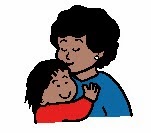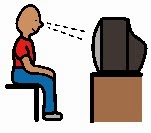We start talking to our children the day they are born, even though we know that we are not going to hear a “word” back from them for some time to come. Research suggests that the average 18 month old has been exposed to over 4,380 hours of oral language – about 8 hours each day. Jane Korsten (Speech Language Pathologist) did the math to demonstrate that if we only provide speech and language therapy sessions two times per week for a child who has a communication system, it will take 84 years to reach the same amount of language exposure. If we are going to successfully teach a child how to use symbols, we are going to need to do a little more than that weekly therapy. Luckily, there are lots of things that we can do to help support a child’s communication development.
 Our children who are using AAC need to see their language
“in action”. Having others use the same AAC system to communicate allows our
students to make connections between symbols and their meanings; shows them how
to find symbols; how to put words together to make sentences; how to add word
endings … They need to see it happen in order to do it themselves. On the flip
side, modeling use of an AAC system also gives us a little bit of insight into what it
takes to learn and use a system effectively. The only way to become proficient in using a
personal communication display or speech generating device is to use it.
Our children who are using AAC need to see their language
“in action”. Having others use the same AAC system to communicate allows our
students to make connections between symbols and their meanings; shows them how
to find symbols; how to put words together to make sentences; how to add word
endings … They need to see it happen in order to do it themselves. On the flip
side, modeling use of an AAC system also gives us a little bit of insight into what it
takes to learn and use a system effectively. The only way to become proficient in using a
personal communication display or speech generating device is to use it.For an introduction to the technique of Aided Language, take 5 minutes to watch this video from One Kids Place Children’s Treatment Centre in North Bay Ontario.
"Modeling”, “Aided Language Input”, “Aided Language Stimulation”, call it what you will. On the wonderful Uncommon Sense Blog, you can find a great explanation of what is meant by these terms, along with links to some helpful related resources. (Honestly this blog is fantastic – the content that we wanted for our blog this month has already been created by Dana and beautifully put together!).

Check out the handout from the AAC Institute that can be printed out for your child’s team to share the message about modeling.
So, do you want to see all this in action? Again, Dana has done all the work for us by collecting some videos together showing Aided Language Stimulation happening across a number of different situations.
The Hanen Centre is a Canadian not-for-profit charitable organization committed to supporting parents, early childhood educators and speech-language pathologists in their efforts to promote the best possible language, social and literacy skills in young children. As clinicians we frequently talk to caregivers about applying some basic "Hanen" principles when working on communication skills. The information and suggestions found on this website apply to all children who are developing communication skills. Check out the Tips for Parents section on the website for some great suggestions on how to foster communication skills in everyday activities. Here are some things to keep in mind to turn that "work" that you are doing into "play".
First things first:
make it fun!
Communication opportunities happen all around us, throughout the day. Children learn best when they are motivated and having fun – don’t we all? Any play activity is a chance to show your child how language can be used for a purpose. Identify your child’s preferences in order to motivate him to use his communication skills in an activity.
Communication opportunities happen all around us, throughout the day. Children learn best when they are motivated and having fun – don’t we all? Any play activity is a chance to show your child how language can be used for a purpose. Identify your child’s preferences in order to motivate him to use his communication skills in an activity.
 “Look! My car. My car go up! Your turn. Car go up! Down,
down, down. Car go down”.
“Look! My car. My car go up! Your turn. Car go up! Down,
down, down. Car go down”. There is lots more information to be found on the Hanen website that you can use to find out "What Makes Your Child Tick?".
Follow your child’s lead:
As adults we sometimes like to have a plan. As parents or teachers or communication partners, we know that sometimes we have to throw that plan away and follow where our child might take us. Perhaps we thought we were going to play cars this afternoon, but if my child is fascinated with the bubbles in the washing up bowl, maybe we’ll talk about those instead. “Bubbles! I see bubbles! More bubbles! Bubbles go up.”
Observe, Wait & Listen:
Another key consideration from Hanen is to Observe, Wait and Listen (OWL). Here is their description of how this benefits a child engaged in playing with playdough:
Observe – your child and see what she does. Observe silently, really watching to see what she is doing with the playdough. Often, children don’t begin with an idea of what to do with the playdough. They manipulate it and when it starts to look like something they recognize, they may then start to turn it into something specific. To give your child time to come up with her own ideas, just observe without speaking, suggesting or instructing her.
Wait – sit quietly and avoid showing your child things she could do with the playdough. Just squeeze or roll your own playdough slowly. Your goal is to give your child an opportunity to do what SHE wants to do FIRST.
Listen – to what she says, without interrupting. If she says something, respond and show interest, but avoid telling her what to do or try not to ask questions that test, such as “What are you doing?”, or “What are you making?” She probably doesn’t know yet - she’s still experimenting!
Talk using simple repetitive language:
Model slowly so that your student can see which vocabulary items you are pointing to and can follow along. Carol Goossens recommends the following guidelines when providing aided language stimulation for children:
- use primarily single words (symbols) and short grammatically correct phrases (symbol phrases) to talk about what the child is hearing, seeing, doing and feeling
- use lots of repetition as you describe ongoing events (lots of opportunities to practice)
- speak slowly, inserting numerous pauses into the conversational flow
- whenever the child indicates something with a single word (symbol), expand that message into a semantically equivalent two-word (symbol) combination.
Model by using one or
two words more than you child is currently using:When using an augmentative communication system to model
language, not every word needs to be selected on the display or device as we
are talking. To teach our students how
to take the next steps, we can keep adding to what we are saying. Start with
one word and when we know that our student can manage that, add on another.
Keep building language one step at a time.
Use “think outloud” strategies:
When selecting words on a display, it can help to talk through the process so that your child can follow along. We can share with our students the connections that we make that help us to remember where to find a specific word. Often these connections are made through life experience - our students maybe don't share these connections yet, but we can help them with some explanation as we search for words. "I want to ask for a big cookie, so let's see how I can say 'big'. I think maybe it's here - I see an elephant and he's really BIG. Let's see... yes, there it is: 'big'. I want big cookie!"
How much is too much?
Use “think outloud” strategies:

When selecting words on a display, it can help to talk through the process so that your child can follow along. We can share with our students the connections that we make that help us to remember where to find a specific word. Often these connections are made through life experience - our students maybe don't share these connections yet, but we can help them with some explanation as we search for words. "I want to ask for a big cookie, so let's see how I can say 'big'. I think maybe it's here - I see an elephant and he's really BIG. Let's see... yes, there it is: 'big'. I want big cookie!"
How much is too much?
When modeling language, when do we immerse our students in
language and when do we need to consider more focused modeling? Gail VanTatenhove has some suggestions around providing modeling for students who may
have visual, auditory and /or motor processing challenges.
Practice, practice, practice…
When you read the information, this whole process sounds kind of straightforward… we point to pictures as we talk. Which leads us to wondering why we are not necessarily seeing everyone modeling language on communication displays or devices when we walk into classrooms or clinics or homes… In reality, being able to model language for children using any form of AAC takes practice. We need to slow down and think about what we are saying. We need to know where all those symbols are located before we can show our students where they are. Sometimes, especially for a system with lots of vocabulary, this means that we need to spend some time learning where the messages are located ourselves. One way to do this is to make a paper-based copy of what’s on the student’s system. That way, we can get to know the communication system better, without having to take it away from the student.
Some words of wisdom, as always, from Praactical AAC about "Getting the Team On Board".
Start a modeling revolution…
 Share the idea of modeling with family, colleagues, peers.. if
everyone starts to point to symbols as they speak, perhaps others will follow
along. Make some extra copies of the core board that is used in your classroom
and throw on a sign that invites others to join in: “Welcome to our classroom.
Grab a board and come talk with us!”
Share the idea of modeling with family, colleagues, peers.. if
everyone starts to point to symbols as they speak, perhaps others will follow
along. Make some extra copies of the core board that is used in your classroom
and throw on a sign that invites others to join in: “Welcome to our classroom.
Grab a board and come talk with us!”Want more?
There is so much information online about this topic... a great place to start is back at Praactical AAC, where there are many posts with related resources.
(Original Post April 1, 2015, Updated July 24, 2020)





No comments:
Post a Comment